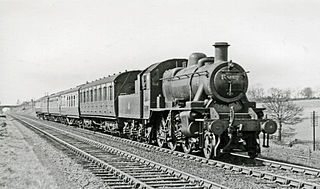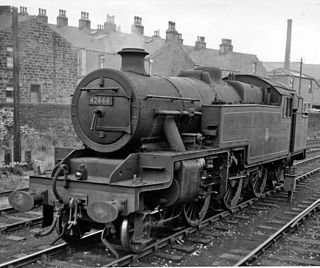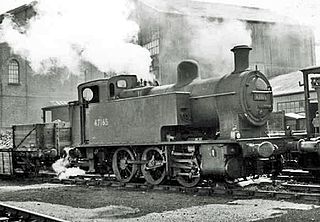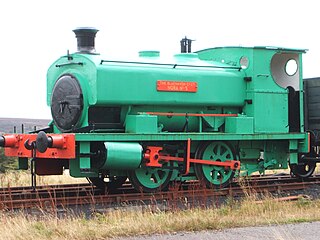| LMS Kitson 0-4-0ST | |||||||||||||||||||||||||||||||||||||||||
|---|---|---|---|---|---|---|---|---|---|---|---|---|---|---|---|---|---|---|---|---|---|---|---|---|---|---|---|---|---|---|---|---|---|---|---|---|---|---|---|---|---|
 No. 47001 at Barrow Hill (Staveley) Locomotive Depot 23 August 1963. | |||||||||||||||||||||||||||||||||||||||||
| |||||||||||||||||||||||||||||||||||||||||
| |||||||||||||||||||||||||||||||||||||||||
| |||||||||||||||||||||||||||||||||||||||||
| |||||||||||||||||||||||||||||||||||||||||
The London, Midland and Scottish Railway (LMS) Kitson 0-4-0ST was a class of 0-4-0 saddle tank steam locomotive designed for light shunting.
| LMS Kitson 0-4-0ST | |||||||||||||||||||||||||||||||||||||||||
|---|---|---|---|---|---|---|---|---|---|---|---|---|---|---|---|---|---|---|---|---|---|---|---|---|---|---|---|---|---|---|---|---|---|---|---|---|---|---|---|---|---|
 No. 47001 at Barrow Hill (Staveley) Locomotive Depot 23 August 1963. | |||||||||||||||||||||||||||||||||||||||||
| |||||||||||||||||||||||||||||||||||||||||
| |||||||||||||||||||||||||||||||||||||||||
| |||||||||||||||||||||||||||||||||||||||||
| |||||||||||||||||||||||||||||||||||||||||
The London, Midland and Scottish Railway (LMS) Kitson 0-4-0ST was a class of 0-4-0 saddle tank steam locomotive designed for light shunting.
Five were originally designed and built by Kitson and Company of Leeds to LMS specification in 1932 and numbered 1500–1504. They were similar to other shunters built for industrial use. The manufacturer's works numbers were 5644–5648. [1] The LMS classified them 0F. These were later renumbered 7000–7004 in 1935/1936. British Railways (BR) added 40000 to their numbers after nationalization in 1948, becoming 47000–47004. Between 1953 and 1954, BR constructed an additional five at Horwich Works, numbered 47005–47009. These differed from the original batch having shorter saddle tanks with extra space given to longer coal bunkers instead.
Some saw use on the Cromford and High Peak Railway in Derbyshire. Withdrawals took place between 1963 and 1966, and no examples were preserved.
| 1932 No. | 1935 No. | BR No. | Builder | Works No. | Date built | Date withdrawn | Notes |
|---|---|---|---|---|---|---|---|
| 1500 | 7000 | 47000 | Kitson | 5644 | 1932 | 1966 | |
| 1501 | 7001 | 47001 | Kitson | 5645 | 1932 | 1966 | |
| 1502 | 7002 | 47002 | Kitson | 5646 | 1932 | 1964 | |
| 1503 | 7003 | 47003 | Kitson | 5647 | 1932 | 1964 | |
| 1504 | 7004 | 47004 | Kitson | 5648 | 1932 | 1964 | |
| n/a | n/a | 47005 | Horwich | 1953 | 1966 | ||
| n/a | n/a | 47006 | Horwich | 1953 | 1966 | ||
| n/a | n/a | 47007 | Horwich | 1953 | 1963 | ||
| n/a | n/a | 47008 | Horwich | 1953 | 1964 | ||
| n/a | n/a | 47009 | Horwich | 1954 | 1964 |
In The Railway Series books by the Reverend W. Awdry, a character called 'Pug' appears in the 12th book, The Eight Famous Engines. After problems of consistent accuracy of the drawings in the early books, later characters were based more closely on real locomotives. Although not explicitly identified by Awdry, the locomotive in the illustration by John T. Kenney, [2] has been identified as most closely resembling a LMS Kitson 0-4-0ST. [3]

The London Midland and Scottish Railway (LMS) Jubilee Class is a class of steam locomotive designed for main line passenger work. 191 locomotives were built between 1934 and 1936. They were built concurrently with the similar looking LMS Stanier Class 5 4-6-0. They were nicknamed Red Staniers and Jubs.

The British Railways Class D3/7 is a class of 0-6-0 diesel electric shunting locomotives built as LMS Nos. 7080–7119. The class were built from May 1939 through to July 1942 by the London, Midland and Scottish Railway at their Derby Works using a diesel electric transmission supplied by English Electric.

The London, Midland and Scottish Railway (LMS) Fairburn Tank 2-6-4T is a class of steam locomotive. They were designed by Charles E. Fairburn for the LMS. 277 of these locomotives were built between 1945 and 1951, numbered in the range 42050–42186, (4)2187–(4)2299, (4)2673–(4)2699.
The London, Midland and Scottish Railway (LMS) pioneered the use of diesel shunting locomotives in Great Britain. The variety of experimental and production diesel shunters produced by the LMS is summarised below.

The London, Midland and Scottish Railway (LMS) Stanier Class 5 4-6-0, commonly known as the Black Five, is a class of 4-6-0 steam locomotives. It was introduced by William Stanier and built between 1934 and 1951, of which 842 were built and were numbered 4658-5499. Several members of the class survived to the last day of steam on British Railways in 1968, and eighteen are preserved.

The London, Midland and Scottish Railway (LMS) Stanier Class 8F is a class of steam locomotives designed for hauling heavy freight. 852 were built between 1935 and 1946, as a freight version of William Stanier's successful Black Five, and the class saw extensive service overseas during and after the Second World War.

The Patriot Class was a class of 52 express passenger steam locomotives built for the London Midland and Scottish Railway. The first locomotive of the class was built in 1930 and the last in 1934. The class was based on the chassis of the Royal Scot combined with the boiler from Large Claughtons earning them the nickname Baby Scots. A total of 18 were rebuilt to create the LMS Rebuilt Patriot Class between 1946 and 1948; thereafter those not subjected to rebuilding were often referred to as the Unrebuilt Patriot Class. These remaining 34 unrebuilt engines were withdrawn between 1960 and 1962.

The London, Midland and Scottish Railway (LMS) Stanier Class 2 0-4-4T was a class of 10 light passenger locomotives built in 1932. Ostensibly designed under new Chief Mechanical Engineer (CME) William Stanier, they were in fact the last new design of the Midland Railway's school of engineering.

The London, Midland and Scottish Railway (LMS) Ivatt Class 2 2-6-0 is a class of steam locomotive designed for light mixed traffic.

The London, Midland and Scottish Railway (LMS) Ivatt Class 2 2-6-2T is a class of light 'mixed-traffic' steam locomotive introduced in 1946.

Sir William Stanier's London, Midland and Scottish Railway (LMS) Class 4P 2-Cylinder 2-6-4T was a class of 206 steam locomotive built between 1935 and 1943. They were based on his LMS 3-Cylinder 2-6-4T.

The London, Midland and Scottish Railway (LMS) Fowler 2-6-4T was a class of steam locomotive passenger tank engine designed by Henry Fowler.

The London, Midland and Scottish Railway (LMS) Fowler Dock Tank was an 0-6-0T steam locomotive. Designed for shunting in docks, it had a short wheelbase in order for it to readily negotiate tight curves. The locomotives spent their entire lives painted in plain black.

The London, Midland and Scottish Railway (LMS) Fowler 3F0-6-0T is a class of steam locomotives, often known as Jinty. They represent the ultimate development of the Midland Railway's six-coupled tank engines. They could reach speeds of up to 60 mph (97 km/h).

The Lancashire and Yorkshire Railway Class 28 was a class of 0-6-0 steam locomotive, designed by George Hughes for the Lancashire and Yorkshire Railway (L&YR). It was a rebuild of Aspinall's Class 27, with the addition of a Belpaire firebox and the extension of the footplate and front sandboxes. It was similar, but had larger cylinders and a superheater. It had 5-foot-1-inch (1.549 m) wheels.

The London Midland and Scottish Railway (LMS), Rebuilt Patriot Class was a class of 4-6-0 steam locomotives. They were rebuilt from LMS Patriot Class locomotives over the period 1946–1949. By the end of 1947, the LMS had rebuilt seven engines, these being 5514/21/26/29–31/40. After nationalisation, a further eleven locomotives were rebuilt. Rebuilt locomotives retained their numbers.

The London, Tilbury and Southend Railway (LTSR) 79 Class is a class of 4-4-2T suburban tank engines. They were designed by Thomas Whitelegg, as a development of the earlier 37 Class. They could reach a top speed of 65 mph.
The London, Midland and Scottish Railway and British Railways Class 4 2-6-4T was a family of classes of steam locomotives. A grand total of 800 engines were built to five separate designs by four different mechanical engineers, over a period of 29 years. Each new design was a development of the previous one. The LMS gave the whole family the power classification 4P, BR 4MT. It is therefore worth considering them as a group as follows:

'Pug' locomotives are small steam locomotives which were produced for light shunting work, usually at dockyards, factory sites, steelworks, collieries, and other similar locations. The name is derived from a common term in Scotland for a small industrial shunting engine, typically an 0-4-0 tank.